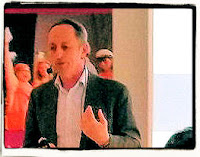Few, Simple Messages are the Key to Effective Speeches, Presentations
All of the people I coach one-to-one know their topic and they have interesting things to say. The only problem lies in selecting and organizing this material.
My experience is that the best way to address this task is to start with the result. Rather than collecting information then trying to organize it, what usually works better is to start with the end result and work backwards. There are three steps in this process.
Choosing the Key Messages. First of all you have to define exactly what you want the audience to think at the end of the presentation. Remember that if this is not clear in your head then it will be difficult to plant a clear idea in other people's heads. You should choose one, two or three key messages at this stage. In theory you could try to communicate more, but in practice the extra messages will not only be lost, the noise will also cover the other messages. It is unrealistic to expect an audience to retain more than three messages, even if they are all PhD candidates.
Select points that support these messages. Once the messages are defined for each of them choose the points, data and anecdotes that will support these messages. Exactly how you do this is a matter of personal choice. Some people do it in their head, others prefer a whiteboard and a few like to use Post It notes. Techniques like Mind Maps can also help in this stage. You might also start to choose some illustrations that support your messages at this point.
Structure the material logically. Take all the messages, points, examples, jokes, stories and so on that you have collected and organize them into a logical flow. This logical structure will make it easier for people to follow your reasoning. It also makes the speech easier to remember and deliver. Make sure that the structure is driven by the messages and the points rather than the illustrations. One very common problem in speaking and presenting is to start with the illustrations and talk around them. This tends to make the messages less clear and the presentation less logical.
Once you have reached this stage there is still one more very important thing to do: test and revise. Always test a speech or a presentation and revise the content until you are confident that it runs smoothly and resonates with the audience. Find a test audience to test it before you ever try it on a real audience, and for the most important occasions try to find an audience that is similar to your target audience.
Lectures, Workshops, Coaching and Writing
Contact Andrew Hennigan at speaker@andrewhennigan.com or 0046 730 894 475 if you would like lectures, workshops or one-to-one coaching for speaking, presenting, influencing and more.



Comments